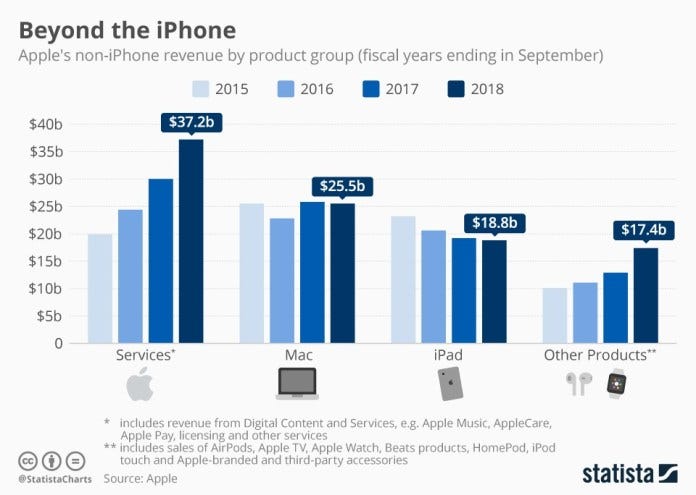Tech Diaries: Apple's Payment Innovations, Starlink's Global Reach
Written on
Chapter 1: Apple's Evolution in Digital Payments
In this inaugural entry of Tech Diaries, I delve into significant developments in the tech industry. For those familiar with my previous series, Crypto Diaries, you’ll notice a similar focus on technological advancements. Let’s explore Apple's latest initiatives.
I vividly recall the excitement I felt when I received my first iPhone years ago. Apple revolutionized the smartphone market, establishing itself as one of the most valuable brands globally. It sits among the elite tech giants known as GAFA (Google, Amazon, Facebook, Apple).
Last year, Apple became the first of these titans to reach a $1 trillion valuation, soon followed by Amazon and Microsoft. Although recent market corrections have reduced their valuations, all four companies remain close to that esteemed milestone.
Apple's growth has largely depended on its flagship product, the iPhone. Despite facing fierce competition from Samsung and Huawei, Apple has maintained a loyal customer base. However, since around 2016, growth began to plateau due to increased competition and shrinking profit margins.
Recognizing the need for diversification beyond the iPhone’s allure, Apple introduced services like Apple Music, the App Store, iCloud subscriptions, and new products such as the Apple Watch and AirPods. This pivot has revitalized the company's revenue streams. A crucial announcement in this transition occurred in March with the unveiling of the Apple Card.

The Apple Card represents a cutting-edge digital payment solution that prioritizes user convenience. Key features include no late fees, immediate qualification, up to 3% cashback, and a simplified interface. While Facebook is contemplating its own payment system for its platforms, Apple has already made significant strides in revolutionizing financial transactions.
A notable advantage Apple holds over Facebook is the trust it has cultivated with its users. The Daily Cash App enhances user experience by offering interactive tools to monitor balances, cash-backs, and expenses. This will further solidify Apple's ecosystem of applications, services, and hardware.
Additionally, Apple has assured users that their spending habits won’t be monitored — a credible promise considering its lack of data breach scandals, unlike Facebook and Google, which rely heavily on third-party advertisements for revenue. Developments like these are shaping the future landscape of finance, and this summer will reveal how consumers embrace the Apple Card. The catch? Are users willing to invest in a $1000 smartphone to access these features?
Chapter 2: Global Internet Connectivity and SpaceX
In the realm of global internet access, I regard Elon Musk as a visionary, despite his occasional controversies. He is the mastermind behind numerous groundbreaking companies, including Tesla, Solar City, SpaceX, and Neuralink.
SpaceX recently launched its first batch of 60 satellites for the Starlink project, aimed at providing global broadband internet by transmitting signals from low-Earth orbit. Ultimately, achieving universal connectivity will require a constellation of approximately 12,000 satellites, which will communicate via lasers and deliver internet speeds significantly faster than existing satellite services.
The Falcon 9 rocket successfully deployed these satellites, while Amazon’s Jeff Bezos plans to initiate a similar effort named 'Project Kuiper' with 3,236 satellites set to launch in 2021. Both initiatives represent pivotal steps toward closing the global digital divide.
Nevertheless, critics raise concerns about the potential increase in space debris from such extensive satellite launches. Scientific American warns of a scenario where this could lead to "Kessler syndrome," creating a cascade of debris that could hinder space access for humanity. In response, SpaceX claims their satellites will operate in a lower orbit, minimizing interaction with existing debris and simplifying their retirement after five years, as per NASA's guidelines. Let's keep a positive outlook on these advancements!

Chapter 3: Microsoft's Shift Toward Blockchain Technology
Microsoft has undergone a remarkable transformation, evolving from a dominant software provider in the 1990s to a forward-thinking service-oriented company under the leadership of CEO Satya Nadella. The company’s impressive performance is reflected in its strong revenue growth.
Notably, of Microsoft’s $110.36 billion revenue in 2018, $27.6 billion came from its Azure Cloud services. Recently, Azure has embraced blockchain technology, introducing a development kit and the Azure Blockchain Workbench.
Two weeks ago, Microsoft launched Azure Blockchain Services, a fully managed Blockchain as a Service (BaaS) platform, enabling the formation and governance of consortium blockchain networks. This platform also supports advanced tools for developers, including AI and IoT capabilities. Following suit, Amazon unveiled its own BaaS platform, Amazon Managed Blockchain (AMB).
Moreover, Microsoft announced its plans to create a decentralized identity (DID) network built on the Bitcoin blockchain. This open standards infrastructure, known as the Identity Overlay Network (ION), aims to empower users with control over their data while ensuring privacy and security. The mainnet is expected to launch in the coming months, signaling a broader adoption of blockchain technology among major corporations.
Before concluding, it’s essential to briefly address Huawei’s current situation amid escalating trade tensions. The U.S. has imposed significant restrictions on Huawei, preventing American companies from utilizing its equipment or supplying essential components. Facing challenges in rolling out 5G networks globally, Huawei may encounter additional hurdles ahead.

The second video titled "Blastoff! SpaceX launches Starlink batch from California to complete doubleheader" showcases SpaceX's successful satellite launch, which is crucial for expanding global internet access.
In summary, significant advancements in digital payments, global connectivity, and blockchain technology are reshaping the future landscape of the tech industry.